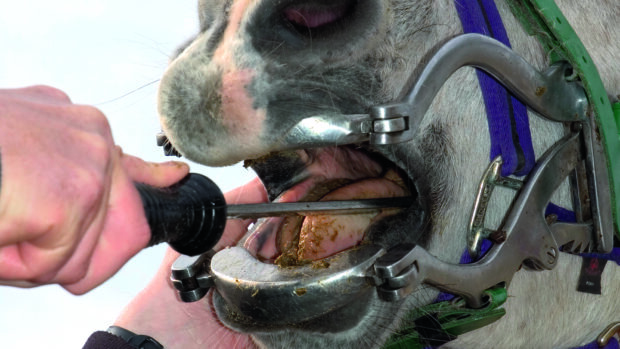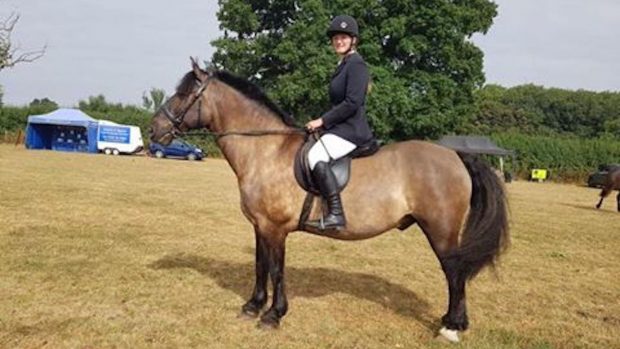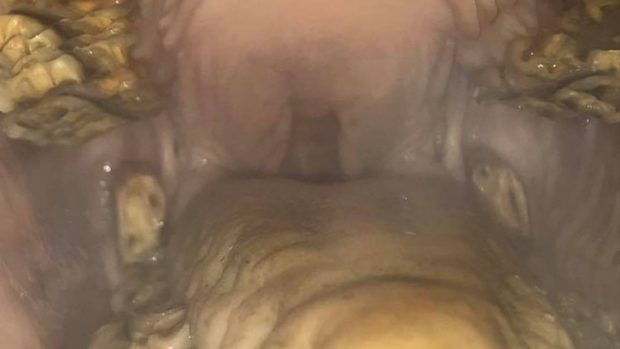Horse teeth are the source of a few colloquial idioms, such as “long in the tooth”, and “don’t look a gift horse in the mouth”. But what of the more serious aspects of equine dental care?
1. How many teeth do horses have?
Like us, horses are diphyodontous, meaning they have two sets of teeth during their lifetime. They lose the baby (or deciduous) set around three to five years of age, which are pushed out by the adult set. Adult horses have around 36–42 teeth. Male horses tend to have 40, while mares usually have 36–40. This is because the majority of mares do not grow canine teeth.
2. What type of teeth do horses have?
Equines are heterodontous – which means their mouths contain different shapes of teeth for different purposes.
- Premolars and molars, also called cheek teeth: for chewing and grazing, these make up more than half of the teeth in the horse’s mouth, with six of each on the top and bottom jaw each side.
- Incisors: the 12 teeth at the front of the mouth (six upper and six lower), used for biting off grass and grabbing hay – or nipping each other and other unwanted behaviours!
- Canines or tushes: short, sharp teeth found in male horses and a small proportion of mares, in between the incisors and cheek teeth. Originally used for fighting and serve no purpose in the modern horse
- Wolf teeth: not present in all horses. Wolf teeth are often removed as they can interfere with the bit placement in the ridden horse and cause contact issues.
3. Why do we need to rasp teeth?
A horse’s tooth and root are several inches long. Each tooth continues to erupt through the gum at a rate of 3mm per year on average, with more tooth emerging in the younger horse.
Horses were originally designed to eat coarse vegetation for 18-20 hours per day. The modern horse, however, is largely fed on lush grass and soft hay and their chewing time has changed with the different diet. Another factor is horses eating with their heads up, for example munching from haynets can alter tooth wear.
These changes produce extremely sharp points, which can damage the soft tissues within the mouth and need to be removed by rasping – also called floating.
Unlike humans, horses have hypsodont teeth, which have enamel extending into the gumline and the nerves are deeper within the tooth so floating does not cause them pain unless it is overdone. Unless, for some reason, a horse takes a severe aversion to the routine rasping process, sedation is unnecessary. However, in cases requiring motorised equipment or where a detailed diagnostic assessment is necessary, judicious use of sedation under vet supervision is appropriate.
4. Can regular dental treatment reduce the risk of colic?
Yes. Horses and ponies who have their teeth checked regularly have been shown to be at reduced risk of colic caused by large colon impaction/distension. But it is important not to over-rasp the teeth, as that may make it hard for the horse to eat and could cause colic.
The pulp is the term applied to the internal blood and nerve supply to a horse’s tooth. Horses’ teeth have a blood and nerve supply that enters at the root (apex) and travels up inside the tooth. These pulps are numerous and communicate with the dentine of the tooth, meaning that equine teeth are very much living structures, to be respected and preserved where possible. If we rasp more than 3-4mm off the surface of a horse’s tooth, we can expose these pulps and potentially cause irreparable damage.
A good rule of thumb is for horses to see the equine dental technician at least once a year, but if there are issues needing monitoring, they may suggest more frequent check-ups.
5. Can dental issues be linked directly to poor performance?
Yes. When a horse is uncomfortable he may hold his head in an unnatural position, which can cause pain in the poll, neck and back. When a horse is asked to work in an outline, he needs to be able to work comfortably in the vertical head position. This means the lower jaw moves forwards slightly owing to the change in body position, so it’s important to make sure there are no overgrowths that would affect this. A tight noseband may make this more uncomfortable for a horse. There is a view that rounding off the front of the second pre-molars helps reduce discomfort — the so-called bit seat.
6. How can you tell a horse is suffering from dental pain?
Slow eating, weight loss, choke, dropping food (quidding) and bad breath are all signs of possible dental pain and should be looked into immediately. But often the signs are much more subtle. As detailed in point 5, some horses may indicate pain in their mouth through poor performance or bad behaviour. Research has also found that the horse grimace scale can be used to identify dental pain.
A horse’s natural chewing action may change in response to pain, but obvious signs of discomfort may not be apparent. They can adjust their chewing patterns to adapt to dental pain, often to the point where owners are unaware that there is a problem. When they eventually show the problem, it may be too late to treat. Meanwhile, the result is the abnormal wearing of the teeth, which may eventually result in severe overgrowths and other painful dental disease.
The good news is that early intervention, through regular veterinary checks and careful rasping, may well prevent many future dental issues.
6. Why might it be necessary to X-ray a horse’s teeth?
Traditional oral examinations can only show about one-tenth of the horse’s tooth. In some cases changes in horse’s teeth can be picked up through a thorough oral examination with sedation, and with use of a dental mirror and more sophisticated techniques, oral endoscopy (examination by camera) shows us a clearer magnified view of the teeth.
Such examinations, however, will only show the part of the tooth visible in the mouth — the clinical crown. To assess the remaining tooth, many vets now use digital X-rays and, in some cases a CT (computerised tomography) scan or a combination of both of these to examine the tooth beneath the gum.

X-ray of a horse’s mouth with the wolf teeth circled.
7. How do I care for my veteran horse’s teeth?
Equine teeth continue to erupt until around 18 years of age. The older horse needs to be treated with caution because, unlike young animals, their cheek teeth have stopped growing and there is no reserve crown left, so any tooth rasped away will never be replaced.
As the horse ages, molars eventually wear out and become level with the gums — this is sometimes called “cupping” or expired teeth. Once this has occurred the horse will require special dietary management. Horses can also develop gaps between their teeth, known as diastema. These gaps become impacted with food, which can lead to painful gingivitis.
Look out for chewed-up balls of forage, and quidding, where the horse spills and drops feed as they chew. Foul-smelling breath and pain when chewing can also indicate tooth abscesses or the presence of compacted feed in a diastema.
Veteran horses with poor dentition will need to be fed appropriately to ensure they receive all the vital nutrients. Short-chopped fibre feeds are a good alternative for horses struggling to chew long-length forage. You could also feed pelleted fibres or feed that needs soaking to ease chewing such as sugar beet pulp. Most feed companies offer a veteran range.
You should also consider a digestive supplement to help the microbes in the gut.
8. How do I tell a horse’s age by its teeth?
This is harder than you might think – it depends on what sort of nutrition the horse has had and how much wear on the teeth. Beyond the age of 10 it’s more of an estimate, even for the experts. Five things to look out for are:
- Occurrence of permanent teeth – for instance, by the age of five, most horses have a full set of adult teeth; tusks in male horses tend to appear around four or five
- Disappearance of cups – indentures in the centres of the surface of the tooth, which gradually disappear to become smooth from six to around 11 years
- Hooks – a hook appears through wear on the upper corner incisor around seven, disappears a year later; repeating at around 13
- Angle of incidence – the older the horse, the more acute the angle of the incisors
- Galvayne’s Groove – a vertical line occurs on the upper corner incisor at around the age of 10, reaching halfway down the tooth at around 15 and the whole way by 20. It then gradually starts disappearing, and is gone altogether on those horses who reach the age of 30
You may also be interested to read…
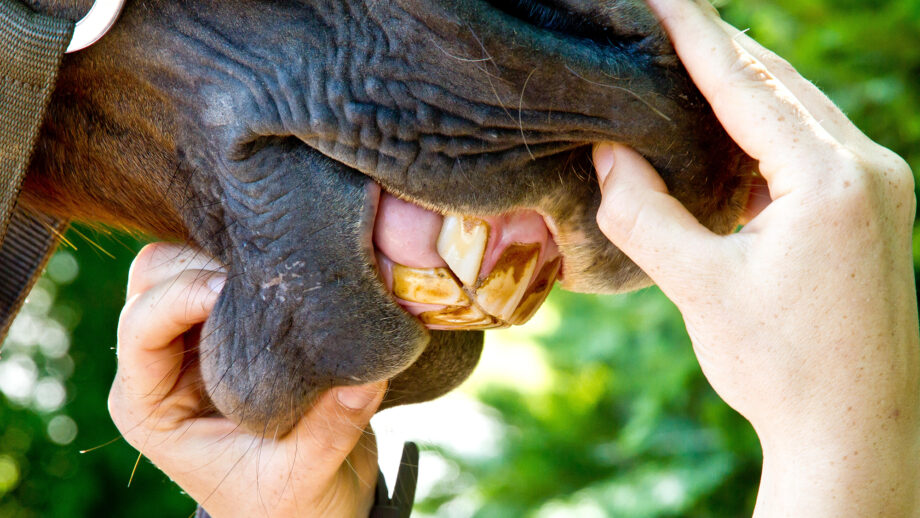
Would you spot if your horse had a tooth infection? Find out how and what treatment is available

Everything you need to know about dental issues in young horses
From caps and gaps to troublesome wolf teeth, Neil Townsend MRCVS outlines the importance of keeping an eye on dental
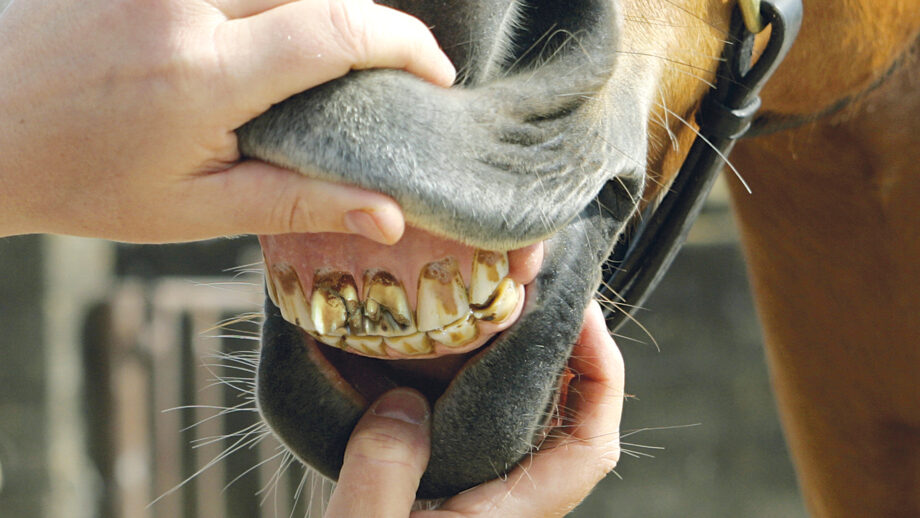
Ask H&H: equine dental fillings
Can they be used to plug a front-tooth gap?

Subscribe to Horse & Hound magazine today – and enjoy unlimited website access all year round
Horse & Hound magazine, out every Thursday, is packed with all the latest news and reports, as well as interviews, specials, nostalgia, vet and training advice. Find how you can enjoy the magazine delivered to your door every week, plus options to upgrade your subscription to access our online service that brings you breaking news and reports as well as other benefits.


